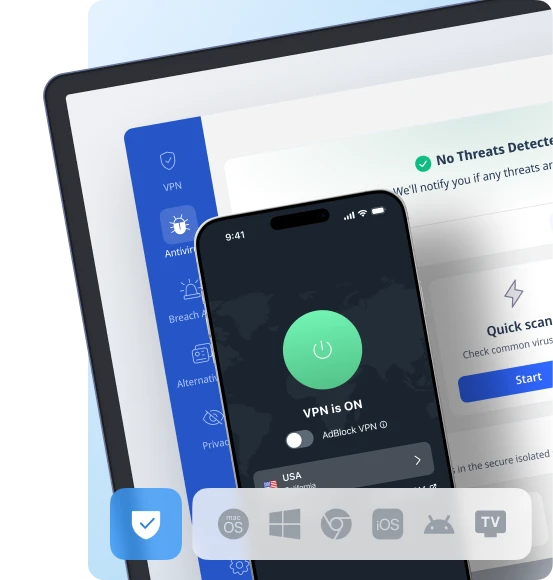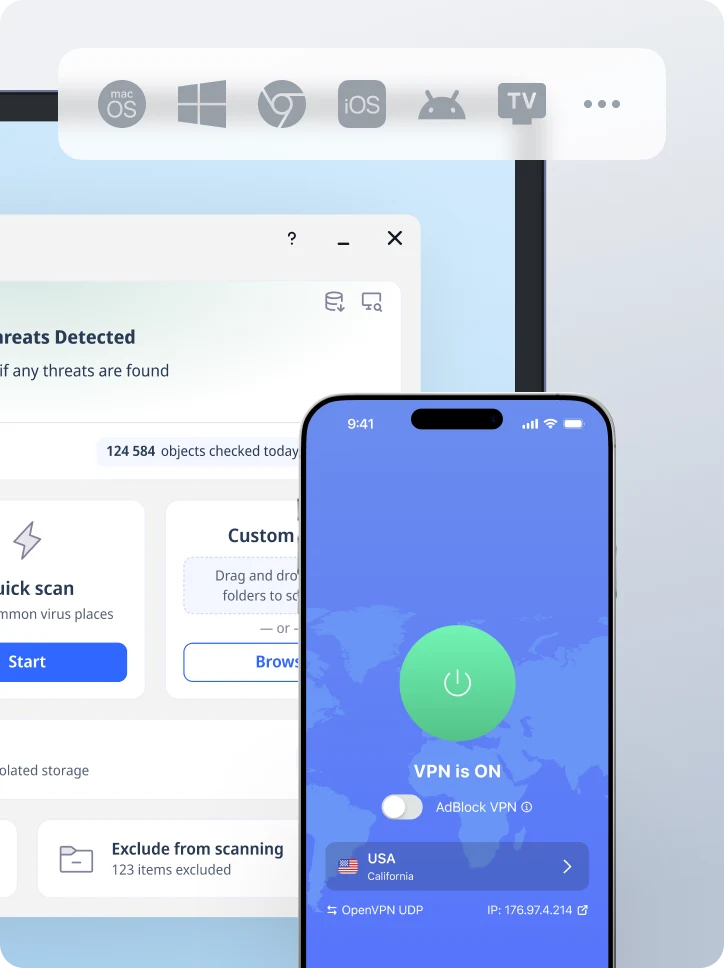What is a Fake Antivirus? How to Spot One Before it Hijacks Your PC?
A rogue security pop‑up screams “Remove 5,000 viruses now!” You click, pay, and nothing improves. It’s because the “helper” you installed was the rogue antivirus program or infection itself. That, in a nutshell, is what is a fake antivirus. These scams pose as antivirus software, but behind the shiny dashboard sits malicious software built to steal data or demand money.
Below you’ll see how crooks craft the illusion, the warning signs most people miss, and why a privacy-first VPN like VeePN shrinks their attack surface.

Stop fake antivirus threats before they even start with VeePN
Let’s start with solving the issue right away. With VeePN, you get:
- Encrypted Internet traffic. Every byte travels through an AES‑256 tunnel, blocking drive‑by installers on hotel Wi‑Fi.
- IP masking. Crooks can’t profile your region, hardware, or antivirus suite version to craft believable upgrade scams.
- NetGuard threat blocker. Malvertising networks and typo‑squatted domains never load when VeePN and its feature, NetGuard, is on. It kills the biggest source of fake antivirus alerts.
- Breach Alert system. An instant heads‑up when your email leaks so you can change passwords before phishers strike.
- Kill Switch for leak protection. If the tunnel hiccups, VeePN cuts traffic rather than expose device details.
- Cross‑platform security. Guard up to ten gadgets: phones, routers, laptops so that all your devices stay scareware‑free.
- Antivirus for Windows and Android. Built-in Antivirus protection detects and removes real threats hiding behind fake antivirus software, giving you peace of mind on your most-used devices.
Let’s see how fake antivirus scams work under the hood:
How fake antivirus scams work
Even though campaigns look different, most follow the same playbook of fear, urgency, and social engineering.
Scare tactics: from pop ups to premium upsells
A classic “computer is infected” banner flashes on screen, sometimes without a click at all — the FBI has warned for years that scareware can self‑install the moment a booby‑trapped ad renders. The window performs a fake scan, displays hundreds of detected threats, and demands an immediate action from you.
Victims are pushed toward a premium version or “full version unlock” that promises to remove viruses. That payment portal is the payday. The recent case detailed how a single fake antivirus renewal email fleeced a retiree of $34,000 after remote‑access “technicians” drained their bank account. Refusal usually doesn’t work — some scareware freezes screens or encrypts files until a ransom is paid.
Infection channels: malicious ads, free downloads, and suspicious links
- Malvertising. Exploiting ad networks, crooks slip malicious JavaScript into otherwise clean sites. ThreatLocker notes a lot of malvertising campaigns that install scareware with zero clicks required.
- Bundled installers. The 2025 Anatsa outbreak began as a harmless “Document Viewer” app in Google Play. One update later, it morphed into a banking Trojan that harvested logins from 50,000 North‑American users while showing convincing maintenance pop‑ups.
- Phishing and SMS links. In Peru, the Zanubis Trojan posed as an energy‑bill checker. A single tap granted accessibility rights, let the malware record screens, and siphoned funds.
Rogue security software vs legitimate security software
Let’s compare the signs of a credible and a shady security software:
| Criteria | Legitimate antivirus software | Rogue security software |
| Digital signature | Signed by the vendor, verified by the OS | Missing or revoked certificates |
| Update source | Pulls patches from the vendor’s CDN | Connects to random IPs or TOR exit nodes |
| Payment methods | Card, PayPal, or app‑store billing | Gift cards, crypto, or wire transfers |
| Uninstall process | One click in control panel | Blocks Task Manager, hides in safe mode |
| Support channels | Official knowledge base and ticket‑desk | Disposable Gmail addresses, no phone trace |
If an “antivirus app” blocks you from uninstalling or only responds through webmail, odds are high it’s not genuine security software.
Red flags that reveal fake antivirus software
Here is what to pay attention to avoid getting into the trap:
| Danger sign | Why it matters |
| Unsolicited scan pop‑ups | Real security software never starts in a browser tab. Close the page and run your own system scan. |
| Bad grammar or odd domains | Buttons like “Immidiate Clean” or URLs full of numbers scream malware. |
| Crypto or gift‑card payments | No legitimate security solutions accept $200 in Bitcoin for “advanced protection.” |
| Disabled system tools | A blocked Task Manager or Windows Security Center often signals a hijacked operating system. |
| Overblown infection counts | “5,478 viruses detected” is scare marketing. Real scanners list exact file paths and threat names. |
| Pop‑ups that follow you between browsers | Cross‑browser persistence usually means a malicious extension or root‑level service, not a friendly reminder. |
| Offer free antivirus software | When a site offers total protection free of charge, particularly by pop-ups or random downloads, then it is a likely trap. |
What to do if you installed fake antivirus programs
Don’t panic, just follow the following steps:
- Disconnect from the internet to stop data leaks.
- Boot into safe mode so the bad service can not auto‑start.
- Scan the entire system using reputable companies such as Microsoft Defender or Malwarebytes.
- Remove unknown installed programs via the control panel and delete shady browser extensions.
- Block identity theft by changing passwords and enabling two-factor authentication.
- Monitor bank and card statements for small “test” charges that hint at bigger fraud.
- Patch everything: outdated browsers and plugins are low‑hanging fruit for the next wave of malicious programs.
But if you want to minimize the chances of getting into such trouble, use VeePN beforehand for a strong protection of your online privacy.
Use VeePN as your first line of defense
Fake antivirus scams feed on sloppy networks, easy fingerprints, and fear. VeePN tackles all three at once: it encrypts every connection so crooks can’t inject drive‑by installers, masks your IP to stop profile‑based lures, blocks malvertising domains before pages load, warns you if leaked credentials surface, and slams a Kill Switch the moment a tunnel blips. VeePN also covers up to ten devices on every major platform simultaneously.
Try VeePN without risks, as we offer a 30‑day money‑back guarantee.
FAQ
A fake antivirus (also called rogue security software) is malware that pretends to be legitimate antivirus software, shows alarming fake alerts, and then asks for money or steals data instead of fixing problems. Read more details in this article.
- Look at the name of the developer in the store
- Authenticate a valid digital signature
- Make sure that updates are made by the vendor.
Anything which asks crypto, blocks uninstallers, or turns off windows security is not legitimate security. Find out more criteria in the VeePN’s article.
VeePN is freedom
Download VeePN Client for All Platforms
Enjoy a smooth VPN experience anywhere, anytime. No matter the device you have — phone or laptop, tablet or router — VeePN’s next-gen data protection and ultra-fast speeds will cover all of them.
Download for PC Download for Mac IOS and Android App
IOS and Android App
Want secure browsing while reading this?
See the difference for yourself - Try VeePN PRO for 3-days for $1, no risk, no pressure.
Start My $1 TrialThen VeePN PRO 1-year plan







